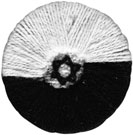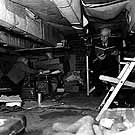
|
|
|

|

|

|

|
|
Click on an image to see a larger, more detailed picture.
|
|
|
|
|
| 1944: Desperate Acts |

|
pg. 511 |

|
|
|
|
| |
 Religious conviction led many Jehovah's Witnesses to shun obedience to the Nazi government. In the dark days of the war in 1943, office worker Mary Smigiel, seen here, became a Jehovah's Witness in Gdynia, Poland. Believing that only Jehovah was to be praised and honored, Smigiel refused her German boss's demand that she type "Heil Hitler" on all correspondence. Her disobedience was reported, and she was sent to the Stutthof, Poland, labor camp. She survived the war, married, and eventually settled in the United States.
Religious conviction led many Jehovah's Witnesses to shun obedience to the Nazi government. In the dark days of the war in 1943, office worker Mary Smigiel, seen here, became a Jehovah's Witness in Gdynia, Poland. Believing that only Jehovah was to be praised and honored, Smigiel refused her German boss's demand that she type "Heil Hitler" on all correspondence. Her disobedience was reported, and she was sent to the Stutthof, Poland, labor camp. She survived the war, married, and eventually settled in the United States.
Photo: Victor Schnell / United States Holocaust Memorial Museum Photo Archive
|
 Even in the horrific conditions prevailing in the concentration camps, inmates sought to preserve some semblance of humanity. This woolen pin, made by an inmate at the Bergen-Belsen, Germany, camp, was presented to Ruth Wiener as a birthday gift.
Even in the horrific conditions prevailing in the concentration camps, inmates sought to preserve some semblance of humanity. This woolen pin, made by an inmate at the Bergen-Belsen, Germany, camp, was presented to Ruth Wiener as a birthday gift.
Photo: United States Holocaust Memorial Museum Photo Archive
|
 For some Jews in the Occupied Netherlands, simply to hide from the Nazis was a gambit that worked--as it did for this elderly couple, Coen and Ella van Eekeres-Jünge, who hid in this tiny Amsterdam basement. Discomfort and inconvenience were the least of the perils associated with hiding; the primary residents of the building had to be completely committed to the safety of their Jewish guests and cognizant of the grave risks to themselves. Also, they had to be wary of antisemitic neighbors and even relatives, as well as the inevitable snooping of Nazi authorities.
For some Jews in the Occupied Netherlands, simply to hide from the Nazis was a gambit that worked--as it did for this elderly couple, Coen and Ella van Eekeres-Jünge, who hid in this tiny Amsterdam basement. Discomfort and inconvenience were the least of the perils associated with hiding; the primary residents of the building had to be completely committed to the safety of their Jewish guests and cognizant of the grave risks to themselves. Also, they had to be wary of antisemitic neighbors and even relatives, as well as the inevitable snooping of Nazi authorities.
Photo: Cas Oorthuys, Netherlands Photo Archive
|
|

|

|

|

|
 January 29, 1944: A Nazi court in Kraków, Poland, sentences five Poles to death for aiding Jews. One of the accused, Kazimierz Jozefek, is hanged in the public square.
January 29, 1944: A Nazi court in Kraków, Poland, sentences five Poles to death for aiding Jews. One of the accused, Kazimierz Jozefek, is hanged in the public square.
|
 January 30, 1944: 700 Jews are deported from Milan, Italy, to Auschwitz.
January 30, 1944: 700 Jews are deported from Milan, Italy, to Auschwitz.
|
 February 1944: Adam Goetz, a Hamburg engineer instrumental in the development of dirigibles, dies in the Lódz (Poland) Ghetto.
February 1944: Adam Goetz, a Hamburg engineer instrumental in the development of dirigibles, dies in the Lódz (Poland) Ghetto.
|
 February 1944: Jewish Resistance leader Moise Fingercwajg, age 20, is executed in France.
February 1944: Jewish Resistance leader Moise Fingercwajg, age 20, is executed in France.
|
 February 4, 1944: 365 Jews from Salonika, Greece, who are under the protection of the Spanish government, leave the concentration camp at Bergen-Belsen, Germany, for Spain and safety.
February 4, 1944: 365 Jews from Salonika, Greece, who are under the protection of the Spanish government, leave the concentration camp at Bergen-Belsen, Germany, for Spain and safety.
|
 February 8, 1944: 1015 Jews are deported from Holland to Auschwitz. Among the deportees are children sick with scarlet fever and diphtheria; See February 10, 1944.
February 8, 1944: 1015 Jews are deported from Holland to Auschwitz. Among the deportees are children sick with scarlet fever and diphtheria; See February 10, 1944.
|
|
|
|
|
| 1944: Desperate Acts |

|
pg. 511 |

|
|
The Holocaust Chronicle
© 2009 Publications International, Ltd.
|
|
